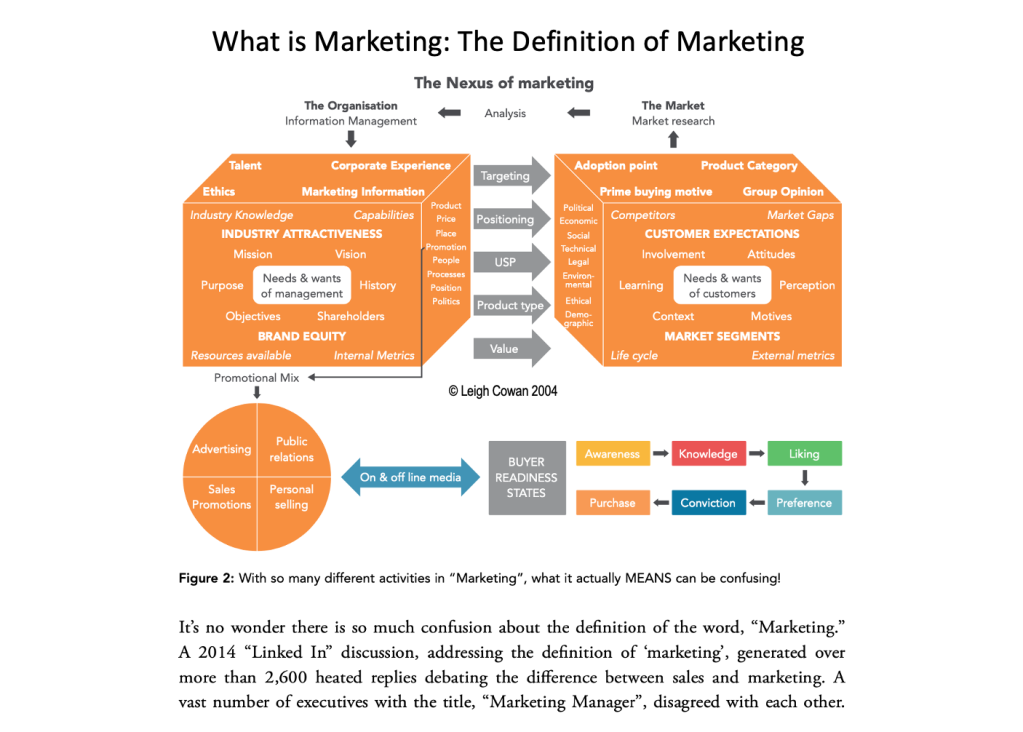
When lay people think about marketing, they often limit their thinking to marketing communications. They think about advertising, giveaways and product samples, other sales promotions and gimmicks, personal selling, public relations activities such as publicity, sponsorship and donations… what professional marketers call “The Promotional Mix”.
What’s your definition of marketing?
So some say it’s the art of ripping off. Some say it’s getting people to buy stuff they don’t need. Some say it’s convincing people to buy. Others say it’s all the communications necessary to implement a sale.
If that is all marketing is, then who should be responsible for pricing? Who should be responsible for choosing who to sell to and who to not? Who should be responsible for setting the method of selling? Who should be responsible for what products you sell, what ingredients go into those products, what purpose those products are being produced for, how those products should be described to intermediaries, as well as final consumers, and what size and varieties of products the firm should offer, how much to produce in what quantities, not to mention what target audience the firm or organisation should dedicate its resources to cultivating?
The answer is that these are all marketing decisions. In fact, one of the most popular definitions of marketing is that of the American Marketing Association, which says, “Marketing is the activity, set of institutions, and processes for creating, communicating, delivering, and exchanging offerings that have value for customers, clients, partners, and society at large.”
But what does that mean?
Encyclopedia Britannica online defines marketing as, “the sum of activities involved in directing the flow of goods and services from producers to consumers”.

It is claimed that Albert Einstein once said, ““If you can’t explain it to a six-year-old, then you don’t understand it yourself”.
So, let’s put the definition of marketing into really simple terms…
“Marketing is the management of exchange.”
Bad marketing is poor management of exchange. Great marketing is optimal management of exchange… where everyone walks away a winner.
So, how do we achieve great marketing?
We achieve great marketing by carefully blending and coordinating all the elements that contribute to an exchange, in such as way as to optimise the outcomes. This is called the Marketing Concept… to focus the organization on satisfying the needs of customers.
To do this we balance “elements of exchange’ which we describe as “the marketing mix” and marketing science identifies seven controllable elements of exchange along with the uncontrollable elements of exchange, painted into a picture which we call the eight P’s of marketing. These “Ps” are product, price, place, promotion, people, processes, perception, and the acronym PESTLEED.
If you are legitimately going to manage all the elements of exchange you have to coordinate holistically the first seven P’s while working in harmony with the PESTLEED, which stands for Politics, Economics, Socio-cultural characteristics, Technological issues, Legal and compliance requirements, Ecological concerns, Ethical parameters, and Demographics (Firmographics in a B2B scenario).
Some marketing academics and theorists debate the 8th P, complaining that it is not a factor that can be controlled. The issue is that the PESTLEED has to be acknowledged; taken into account and worked with, otherwise how can one possibly coordinate the controllable 7Ps in the absence of recognition understanding and coordination of uncontrollable factors?
Anyone developing and creating a marketing strategy (and controlling marketing governance) is mandatorily bound to respect the 8th P for multiple reasons that should be obvious.
All activity, of course, is spawned, shaped and sculpted by the purpose, mission, and vision of the organisation. Hence the needs and wants of the organisation determine the behaviour, culture, intensity, and ferocity of, and approach to, all activities in the management of exchange; and commercial success or failure is a function of the equilibrium between the marketing concept and the drivers of that organisation.
For example, Jeff Bezos single-mindedly applied the marketing concept to, Amazon with the overwhelmingly dominant principle of “obsession with the customer”. It took Jeff Bezos only 20 years to turn a simple online bookshop idea into the world’s biggest company with this single concept.
In contrast, the Apple computer company had an incredibly well-protectedraidly piece of intellectual property in a growing global market, with a sustainable competitive advantage and every market condition possible for success. Yet Apple floundered, and almost failed, at the 20-year mark, taking over 40 years to become the world’s biggest company.
One could argue that had Apple had an “obsession with the customer”, it would have risen toward domination decades before it eventually did. It is whispered that Apple would not have even gone into the mobile phone market had it not bent to the pressure of investors and customers who pushed for Apple to add phone technology to its iPod product range.
Critics of Apple’s senior executive management might say that a lack of marketing competence hampers Apple’s growth, market share, market penetration, productivity and profitability with resistance to (or ignorance of) the needs and wants of the customer. Some might suggest that Apple’s executive management lacks focus towards an ambitious yearning to satisfy the needs and wants of customers at the strategic level while trapped into believing they the operational faux pa of THINKING they are successfully satisfying needs and wants of customers.
The debate about the definition of Marketing
It’s no wonder there is so much confusion about the definition of the word, “marketing”. A 2014 LinkedIn discussion, addressing the definition of marketing, generated more than 2,600 heated replies debating the different beliefs as to the definition of the word, “marketing”. A vast number of executives with the title, of “marketing manager”, disagreed with each other. Even academics struggle, clinging to the 1961 “4Ps” model, developed when marketing experts rode dinosaurs.
The following definition has been the foundation of decades of proven successful marketing plans and strategies. Try it on and see if it fits!
